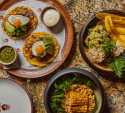Striped chocolate Easter egg
Make your own beautiful homemade Easter gift, using milk, white and plain chocolate, with our ultimate step-by-step guide
-
Prep:45 mins
Cook:10 mins
plus cooling and chilling - More effort
Nutrition per serving
-
kcal 674
-
fat 42g
-
saturates 24g
-
carbs 64g
-
sugars 60g
-
fibre 2g
-
protein 10g
-
salt 0.2g
Ingredients
- 200g good-quality milk chocolate, about 36% cocoa solids
- 200g good-quality white chocolate
- pink food colouring gel (optional)
- 100g plain chocolate, 70% cocoa solids (optional)
- plastic Easter egg mould (made of two halves), either smooth or crackled (see tip)
- wide artist's brush or clean pastry brush
- kitchen thermometer that can read low temperatures
- cotton or plastic gloves (from chemists)
- a box, plus shredded paper or tissue to protect the egg (see tip)
Tip
Tempering chocolateTempering is the process of heating then cooling chocolate to form a specific type of crystals in the cocoa butter. If we simply melt and cool shop- bought chocolate, it will quickly ‘bloom’, with dots and streaks of cocoa butter. It melts quickly when touched too. Tempered chocolate will quickly set hard and shiny, won’t bloom, and shrinks as it cools, making it easy to remove from a mould. Here’s a simple method: Break up 3/4 of the chocolate into a heatproof bowl. Melt until it is flowing and smooth. White chocolate should reach 43C, milk and dark 45C. Add the remaining chocolate, chopped into small pieces. Stir with a spatula until the pieces have melted and the thermometer shows 28C for milk and white, 30C for dark (make sure you are testing the temperature of the chocolate, not the bowl underneath). This can take a while, so have patience and keep stirring. Use as soon as possible. If the chocolate starts to get too cold and thick as you use it, heat for just a few seconds and stir well.
Easter egg mouldsThe large mould used in these photos is about 14cm, medium is 10cm and smaller ones 8cm. Available from specialist cake shops, including Lakeland, costing from £2.
Try covering an old shoebox with pastel paper for an easy homemade gift box.
Choosing chocolateI used supermarket ‘Belgian’ type chocolate – just normal eating chocolate, not cooking chocolate. Some specialist brands may provide you with specific temperatures for their own chocolates.
Leftover chocolateIt’s easier to temper larger amounts of chocolate, so you’re likely to have some white and dark chocolate left over from this recipe. Before it sets hard in the bowl, spoon blobs onto a sheet of parchment and let it set. Wrap and store these for using in baking another time.
Add crunchy caramelTo make a chocolate butterscotch egg with crunchy caramel pieces inside the shell, put 12 Werther’s Original sweets into a bag, crush with a rolling pin, then stir into the cooled chocolate before pouring.
Experiment with patternsUsing the painting technique, you can decorate the egg with all sorts of patterns, or even paint on a name using a small brush – remember to write it backwards, of course.
Method
Wash each half of your Easter egg mould with hot soapy water and a soft sponge, then dry carefully. Using a ball of cotton wool, buff the inside of the mould. The better the shine on the mould, the better the finish on the chocolate.
Melt then temper the white chocolate for the brush strokes (see tip).
Colour half the melted white chocolate with a little of the gel if you want, then brush graphic stripes of chocolate onto the moulds. Let each colour set before you add the next (setting is really speedy if you've achieved good temper). Go over some stripes twice, to make the colours pop out. Repeat the melting and tempering process with the dark chocolate, if you like.
Line a baking sheet with parchment. Melt and temper the milk chocolate. Half-fill one mould with the chocolate, then tip it this way and that to completely cover the mould.
Pour the excess back into the chocolate bowl, and scrape a palette knife across the mould to clean it up. Repeat with the other half of the egg. Set the moulds, flat-side down, on the lined sheet. Transfer to the fridge and leave to set for about 10 mins.
When the chocolate is solid, flex the moulds to gently release. Take your time - you will see the air slowly creepy its way between the plastic and the shiny, hard chocolate. Heat oven to 180C/160C fan/gas 4.
Heat a baking sheet in the oven until warm. Put the gloves on (prevents fingerprints) and pick up one side of the egg. Any messy edges can be melted flat by holding them against the tray. Next, carefully rub the flat edge of the egg on the tray to melt it a little.
Repeat with the second side. If you're struggling to pick up the egg from the tray, use your palette knife to help.
Hold the melted edges of the egg together for a few moments until they stick. Wipe away any excess, then leave the egg to set in the fridge for a few mins. The egg is now ready to give or wrap up for Easter. Store in a cool place away from fluctuating temperatures.





















